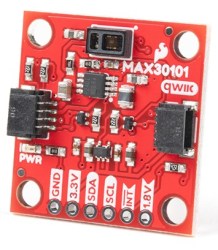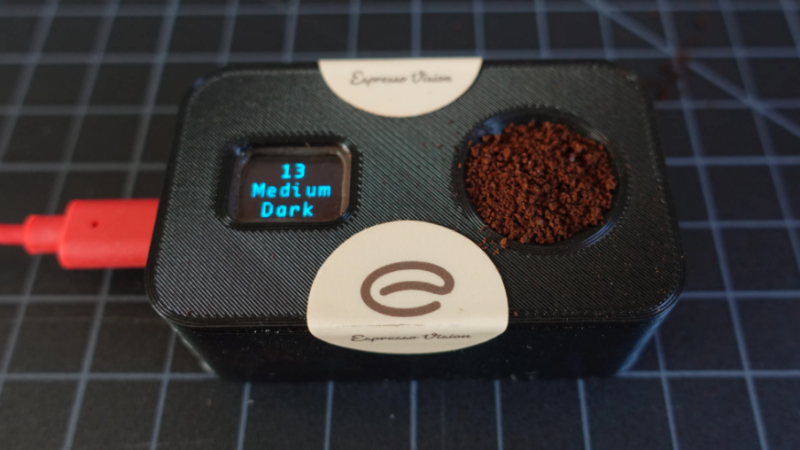
[Zach] is instead using that sensor to measure the roast level of coffee beans, and assign a consistent number from 0 to 35 to represent everything from Very Dark to Very Light. Measuring a bean’s roast level is important to any roaster seeking accuracy and consistency, but when [Zach] found that commercial roast gauges could easily cost over a thousand dollars, he was sure he could do better.
[Zach] settled on using a Sparkfun MAX30101 breakout board to develop his device, and Sparkfun shared an informative blog post that demonstrates how making hardware and tools more accessible can help innovative ideas flourish. The Roast Vision device has a 3D printed enclosure, and a simple top-loading design with an integrated sample cup makes it easy to use. One simply puts about a teaspoon of finely-ground coffee into the sample cup, and the unit provides a measurement in a couple of seconds. Fortunately the sensor works just fine though an acrylic window which means the device can be sealed; a handy feature for a tool that will spend a lot of time around ground coffee.
The joys of fresh roasted coffee is something that is perfectly accessible to those making small batches at home. There are commercial options for small roasters of course, but should you wish to go the DIY route, check out our own Elliot Williams’ guide on making a low-cost DIY roaster.















Nice work! Clever, simple. Looks good too.
” Measuring a bean’s roast level is important to any roaster seeking accuracy and consistency, but when [Zach] found that commercial roast gauges could easily cost over a thousand dollars, he was sure he could do better.”
Wonder how many use the same trick?
Starbucks doesn’t, they burn their beans.
(yecch!)
Use the same trick? Charging thousands? Or overcharging in General? Because this company while seeming like a bargain, $300 for $75 in hardware and code. I get it code takes time and smarts. Worth $300. What bothers me is the $50 repair fee, and they don’t offer repair on the electronics. So it’s $50 for another one of their 10 cents worth of PLA cases. They could at least get using PETG, to make it somewhat durable. And once you’ve got the coding down, it’s literally a Lego piece. The price is definitely inflated due to the market he’s targeting. It feels like the “coffee snobs will buy anything!” Mentality in full force, and I hate that, because it truly makes this beautiful industry disdainful for many.
At first I read “Medium dork:, made me chuckle.
Nice work
#metoo!
A great example of, looking at a product and thinking, I’d like one but it’s too expensive. A regular person would stop there or perhaps look for a second hand unit and still spend too much.
But the hacker mentality, I bet I could make one of those, how hard can it be, more often than not pays off with a little ingenuity. A pretty incredible cost saving, I guess it just goes to show the mark up that gets applied when companies think they have a monopoly.
I wonder if the Banggod $10 Pulse oximeter could be used for this.
One does not simply put about a teaspoon of finely-ground coffee into the sample cup.
What does one do, then?
Whoosh!
I got the meme reference, but also didn’t quite get it, cause, why not?
It’s funny because the original HaD editor wrote “One simply puts about a teaspoon…”, so the obvious retort is to say “one does not simply…”.
I expect he did it on purpose.
Dr. – “What’s the patient’s O2 stats?”
Intern – “13 – Medium Dark”
If your doctor says”O2 stat”, find another doctor. It’s “sat”, short for saturation.
Thank you Donald for posting this!
I’ll try to check here frequently to answer any questions about the product.
We also post a lot on our Instagram for anyone interested in seeing more – https://www.instagram.com/espressovision/
– Zach Halvorson
Some of the early sensor testing I automated using a 3D printed wheel and servo – I think many of the people here would find it really interesting.
I was comparing 3 or 4 different sensors at the time, and would take measurements of ~20 different coffee samples in mere minutes which would have taken me days to do so by hand.
It’s in the earliest posts on my Instagram page, but here’s a good one to start with this one here: https://www.instagram.com/p/CE4cN1DhetZ/
Easy now. The main solution lies in the software algorithm. The hardware is utter uninterestingly and currently overengineered.
Should my coffee tornado ever start making roasted beans instead of shooting flaming beans everywhere I’ll be making one!
Am I the only one who noticed the flaw that requires grinding the beans to determine level of roast? If the sample isn’t correct you either save for blending or trash the sample, can’t re roast.
I noticed that as well. If one is fussy about precisely duplicating their roasts then it needs to be measured in realtime while roasting. Even then the cooling down variable needs to be managed. This still has value though in being able to quantify a roast and subsequently a blend.
Personally, in my roasting I prefer some variability. Though, it’s also easy enough to be able to reasonably duplicate a roast by sight, sound, timing, temperature profile, and time of year (bean humidity levels, outdoor temperature effects on roasting temperature profile & cool down as I roast outdoors all year (±30C) to avoid the smoke detectors screaming).
Cheers
That’s a great point – and when you consider the small sample size required for the Roast Vision, it demonstrates one of the greatest pros of this device compared to others.
Say you finished a roast, and had 200g of roasted beans. If you used any other roast sensor on the market, you’d have to grind ~25 grams of beans in order to take a measurement, and in the case you described where you would re-roast, you would only be able to re-roast the remaining 175 grams.
Compared to the Roast Vision which only needs 1 gram to take a measurement, if you needed to re-roast your beans, you’d have 199g of the original 200g to continue roasting, virtually no loss at all!
Unless, you over roasted them before testing…
Definitely true – I think there’s only one product in the market that does color analysis in real time – https://dailycoffeenews.com/2017/06/15/colortrack-launches-realtime-color-analysis-during-the-roast/